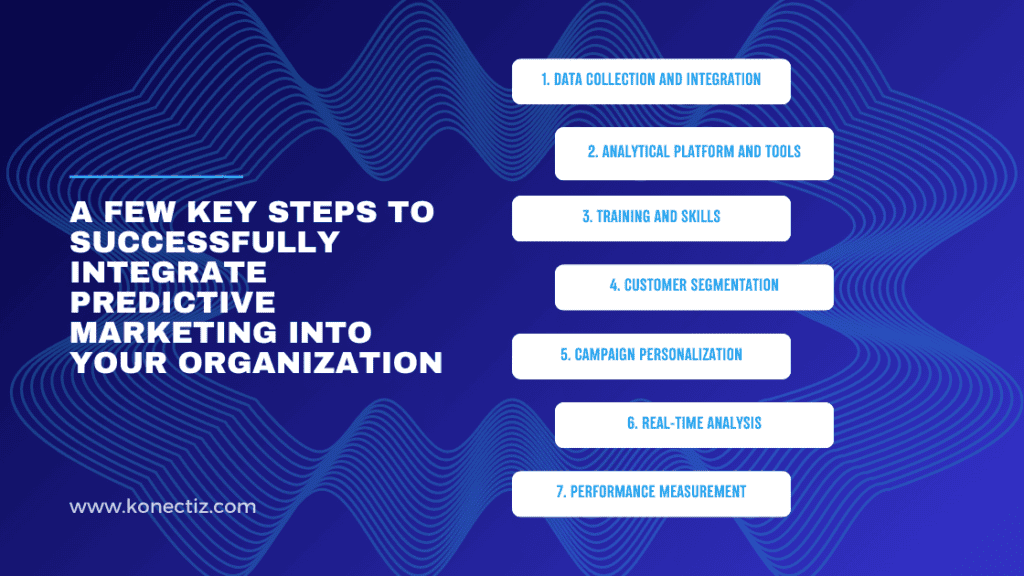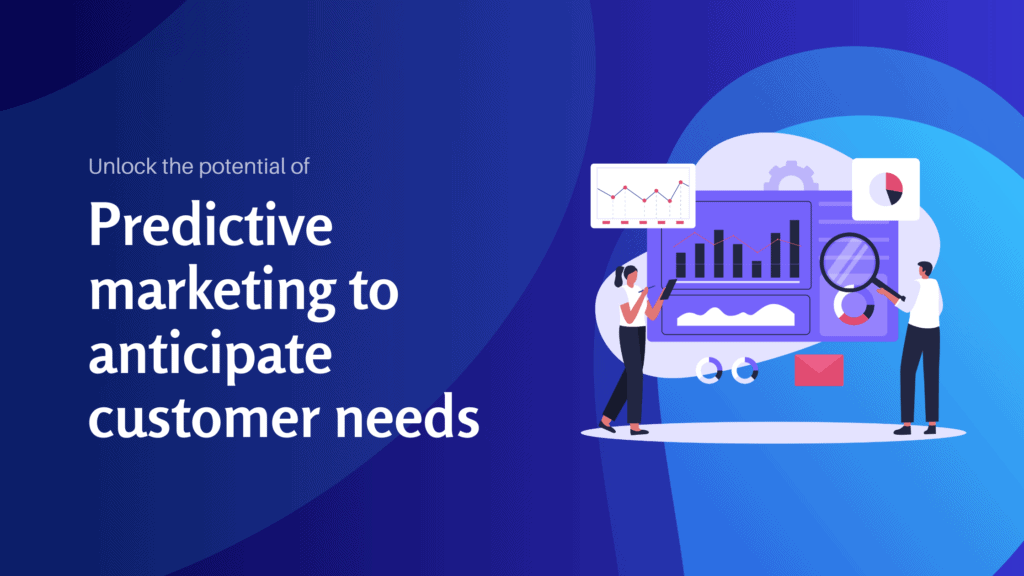Introduction
The ability to predict customer needs is an essential skill for companies that want to stand out in a competitive market. Thanks to the power of predictive marketing, companies can anticipate their customers’ needs, offer them relevant products or services and build stronger relationships.
Imagine being able to predict a customer’s needs before they even express them. This is precisely what predictive marketing enables. Using advanced data and analytics models, brands can identify consumer buying behaviors, preferences and trends, enabling them to personalize their offers and deliver an exceptional customer experience.
What is predictive marketing?
Predictive marketing is based on data analysis, which can come from sources such as purchase histories, online interactions, social networks, demographics and surveys. This data is then used to create predictive models that enable companies to make informed decisions and propose personalized offers to their customers.
The main aim of predictive marketing is to anticipate customer needs and deliver a personalized experience that meets those needs. Using real-time data and predictive analytics, companies can target the right customers, at the right time, with the right offers, resulting in increased sales, greater loyalty and improved customer satisfaction.
The importance of understanding customer needs
Predictive marketing represents a major advance in the way companies can anticipate and respond to their customers’ needs. By harnessing sophisticated algorithms and massive data analysis, predictive marketing enables companies to understand customers’ buying behavior, predict their future preferences and adjust their strategies accordingly. By understanding these trends, companies can not only anticipate customer needs, but also personalize their marketing campaigns to deliver more relevant and meaningful experiences. This creates a closer relationship between brand and customer, strengthening loyalty and increasing overall satisfaction.
The importance of understanding customer needs in the context of predictive marketing lies in the ability to anticipate future demands and offer proactive solutions. Using behavioral data and predictive models, companies can anticipate customer preferences even before they explicitly express them. This anticipation makes it possible to set up targeted marketing campaigns, adjust product and service offers, and propose personalized promotions.
By investing in predictive marketing, companies can not only keep pace with changing consumer expectations, but also position themselves as leaders in innovation and customer satisfaction, establishing a competitive edge. In short, understanding customer needs through predictive marketing is becoming an essential strategy for building solid, lasting customer relationships.
Leveraging data for predictive marketing
Data mining plays a central role in the successful implementation of predictive marketing. Companies collect a multitude of data from various channels, such as online interactions, purchase histories, social networks, customer surveys, and many others. This data is then processed and analyzed using advanced algorithms, enabling the detection of significant patterns, trends and buying behaviors. Using techniques such as machine learning and artificial intelligence, predictive marketing can transform this raw data into actionable information.
One of the main strengths of using data in predictive marketing lies in the ability to segment customers in a fine-grained way. By analyzing demographic, behavioral and transactional data, companies can create customer segments with similar characteristics. This enables marketing strategies to be further personalized, as messages and offers can be tailored specifically to each segment. What’s more, real-time data analysis enables us to react immediately to changes in customer behavior, making it possible to quickly adjust campaigns in line with market trends.
Predictive marketing tools and technologies
Predictive marketing tools and technologies play a crucial role in the successful implementation of strategies based on anticipating customer needs.
Some of the key tools and technologies used in predictive marketing :
1. Advanced analytics
Advanced analytics platforms, such as Google Analytics, Adobe Analytics, and other specific solutions, enable data to be collected, processed and analyzed in real time. They integrate advanced predictive analysis features, helping marketers to understand emerging trends and anticipate future customer behavior.
2. Customer Relationship Management (CRM) systems
CRMs such as Salesforce, HubSpot and Microsoft Dynamics are essential tools for predictive marketing. They centralize customer data, providing a holistic view of the customer journey. By combining CRM data with predictive analytics, companies can personalize their customer interactions and optimize their marketing campaigns.
3. Machine learning and artificial intelligence platforms
Tools such as TensorFlow, scikit-learn, and Microsoft Azure Machine Learning offer machine learning and artificial intelligence capabilities. These platforms enable sophisticated predictive models to be developed, using complex algorithms to analyze data and anticipate customer behavior.
4. Predictive scoring tools
Predictive scoring solutions, such as HubSpot’s Infer, Lead Scoring and others, evaluate the potential of prospects based on various criteria. These tools assign scores to prospects, helping marketing and sales teams prioritize their efforts on those most likely to convert.
5. Marketing automation platforms
Marketing automation tools, such as Marketo, Pardot and Eloqua, automate marketing campaigns using triggers based on user behavior. By combining automation with predictive models, companies can deliver personalized messages at the right time, maximizing the effectiveness of their marketing efforts.
6. Customization platforms
Tools such as Optimizely, Dynamic Yield, and Evergage help personalize online experiences based on behavioral data. By integrating these platforms with predictive analytics, companies can offer more relevant and engaging experiences to their customers.
Developing a predictive marketing strategy
The first step in developing a predictive marketing strategy is to define your objectives and KPIs. What results would you like to achieve with predictive marketing? How will you measure your success? Once you’ve defined your objectives, you can start collecting the necessary data and analyzing it.
The second step is to identify the relevant data sources for your business.
What data do you need to better understand your customers? How will you collect this data? You can use tools such as surveys, web analytics and social networks to collect valuable data on your customers.
The third step is to analyze the data to identify key trends and insights. You can use advanced analysis techniques such as machine learning and predictive analytics to extract valuable insights from your data. These insights can help you better understand your customers’ needs and preferences, and personalize your offers accordingly.
Implement predictive marketing in your company
Implementing predictive marketing in a company requires a strategic approach, the right technological infrastructure and close collaboration between marketing, IT and analytics teams.
A few key steps to successfully integrate predictive marketing into your organization

1. Data Collection and Integration
The first step is to set up a robust data collection system, gathering information from various channels such as websites, social media, points of sale, and more. This data needs to be integrated into a centralized platform for holistic analysis.
2. Analytical Platform and Tools
Invest in advanced analytical tools and platforms that support massive data processing, machine learning and artificial intelligence. Solutions such as data mining tools, predictive analytics platforms and machine learning software are essential for deriving meaningful insights.
3. Training and Skills
Make sure your marketing team is trained to understand and use predictive marketing technologies. Skills in data analysis, statistics and predictive modeling should be reinforced to make the most of the tools available.
4. Customer segmentation
Use the data collected to segment your customer base into homogeneous groups based on criteria such as buying behavior, preferences and demographics. These segments serve as the basis for targeted marketing campaigns.
5. Campaign personalization
Use predictive models to personalize marketing campaigns. This includes personalizing messages, promotional offers and user experiences, creating a more relevant and engaging interaction with customers.
6. Real-time analysis
Set up real-time analysis systems to quickly adjust your strategies in line with market trends and customer behavior. This enables immediate reactivity to changes, maximizing campaign effectiveness.
7. Performance measurement
Establish key performance indicators (KPIs) to assess the effectiveness of your predictive campaigns. Analyze results regularly to adjust your models and continually improve your marketing strategies.
Common challenges of predictive marketing and how to overcome them
To overcome these challenges, it is important to put in place robust data collection and analysis processes. Make sure that your data is of the highest quality and accurately represents your customers. Use advanced analysis techniques to extract valuable insights from your data and create reliable predictive models.
Another approach is to start small and build up gradually. Instead of implementing a large-scale predictive marketing strategy from the outset, start with pilot projects or tests. This will enable you to test and fine-tune your models and campaigns before deploying them on a large scale.
The future of predictive marketing
As the future of predictive marketing takes shape, major advances are anticipated, including the emergence of even more sophisticated predictive models. Advances in artificial intelligence and machine learning should enable finer data analysis, revealing subtle trends and offering even more accurate predictions. These next-generation predictive models could surpass expectations by not only anticipating customers’ immediate needs, but also forecasting longer-term developments, creating a broader and more strategic predictive capability.
At the same time, personalization in predictive marketing is set to reach new heights. By combining data from various sources and using advanced models, companies will be able to personalize each customer interaction in greater depth. Tailor-made offers, hyper-personalized product recommendations and targeted communications will create an exceptionally tailored customer experience, boosting loyalty and engagement.
What’s more, this increased personalization will be closely integrated with other marketing disciplines, including marketing automation and customer relationship management, to offer a holistic, coordinated approach that will maximize the impact of marketing strategies as a whole. Integrating these different facets of marketing will enable companies to build more dynamic customer relationships and optimize every touchpoint along the customer journey.
Conclusion
Predictive marketing offers many advantages to businesses. By anticipating customer needs, brands can offer personalized products or services, increasing the chances of conversion and customer loyalty. What’s more, by using predictive models, companies can optimize their marketing efforts, targeting the right customers with the right offers, thus optimizing advertising budgets and improving ROI.





